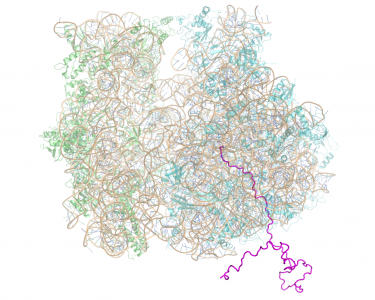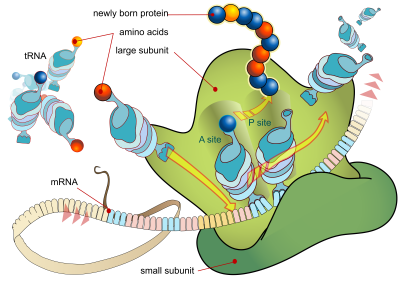Ribosome concept
The term Ribosome refers to large complexes composed of rRNA and proteins, present in the cell’s cytosol, where protein synthesis occurs.
From DNA to Protein
For its processes of growth and metabolism, the cell needs proteins. For this, this same cell makes use of the transcription to read the information stored and contained in the DNA to transcribe it into RNA. Having RNA, the cell carries out translation and synthesizes proteins. These proteins have activity and exert the most varied functions in cell.
While transcription is virtually a copy, because DNA and RNA are very similar in their chemical structure, translation is a much more complex process. This is based on the fact that there are only 4 nucleotides constituting the RNA and there are 21 distinct amino acids that make up the proteins. This problem is overcome by the application of the genetic code that makes the translation of 3 nucleotides simultaneously, called codon, into an amino acid. These amino acids are linked together by peptide bonds and form the proteins.
Ribosoma Characteristics
Translation occurs in large complexes with heavy molecular weight (millions of Dalton), called ribosomes. Ribosomes exist in both prokaryotes and eukaryotes, are composed of 2/3 ribosomal RNA (rRNA) and 1/3 ribosomal proteins and are structurally divided into two distinct subunits that form a complex (figure 1). The interior of the ribosome is formed by the rRNA and the proteins are found in the periphery. Judging from the fact that, typically, there are millions of ribosomes in a mammalian cell, it is possible to conclude about the great importance that these complexes have on cellular activity.
Being characterized by their sedimentation rate, the ribosomes in prokaryotes are called 70S and those in eukaryotes are larger and are called 80S. The 70S ribosomes are composed of a small subunit, entitled 30S, composed of 16S rRNA and 21 proteins; and a large subunit, entitled 50S, composed of 23S and 5S rRNA and 34 proteins. In the case of the 80S ribosomes, they are composed of a small subunit, 40S, composed of 18S rRNA and 30 proteins; and by a large subunit, 60S, composed of 28S, 5,8S and 5S rRNA and 45 proteins.

Figure 1 – Illustrative image of a ribosome’s three-dimensional structure.
In inactive eukaryotic cells, the ribosomes subunits are separated. If the cell starts the translation, the subunits are assembled in the nucleus and then transported to the cytoplasm. In the cytoplasm, the ribosome subunits have distinct functions in the protein synthesis: the small subunit is responsible for providing a location for the correct association between the tRNA (carrying the anti-codon) and the codon; while the large subunit is responsible for catalyzing the formation of the peptide bond between the amino acids for the polypeptide formation. In their active site, ribosomes have 3 sites (called E, P and A) where the tRNAs bind to the complementary codons (figure 2). The eukaryotic cell ribosomes are extremely efficient: in a second 2 amino acids are added to the growing polypeptide chain.

Figure 2 – Schematic image of an active ribosome. It is possible to observe the small and large subunits, tRNA, mRNA and the newly born protein.
Ribosomes synthesizing proteins are anchored to the rough endoplasmic reticulum or free in the cytoplasm, depending on the type of proteins being synthesized.
References:
Alberts B., Johnson A., Lewis J., Raff M., Keith R., Walter P. (2007). Molecular Biology of the Cell (5th edition). Garland Science, New York.
Berg J.M., Tymoczko J.L., Stryer L. (2002). Biochemistry (5th edition). W. H. Freeman, New York.
Cooper G.M. (2000). The Cell: A Molecular Approach (2th edition). Sinauer Associates, Sunderland (MA).
Griffiths A.J.F., Wessler S.R., Lewontin R.C., Gelbart W.M., Suzuki D.T., Miller J.H. (2004). An Introduction to Genetic Analysis (8th edition). W. H. Freeman, New York.
Lodish H., Berk A., Zipursky S.L., Matsudaira P., Baltimore D., Darnell J. (2000). Molecular Cell Biology (4th edition). W. H. Freeman, New York.




